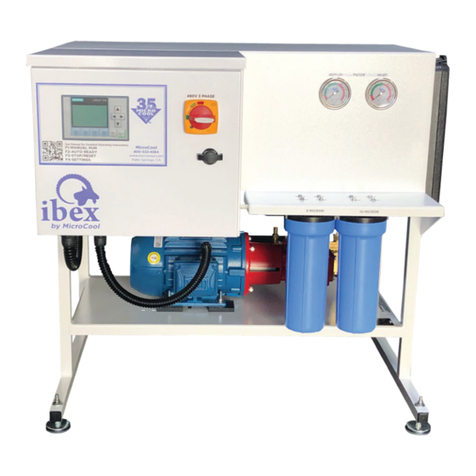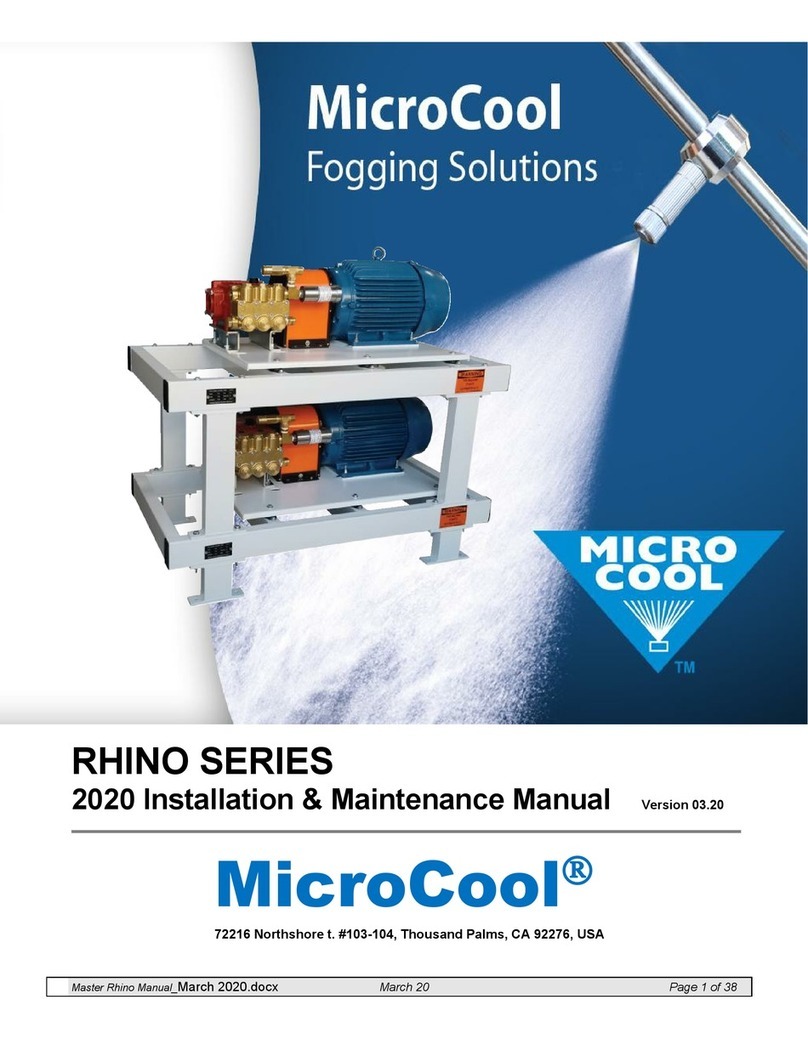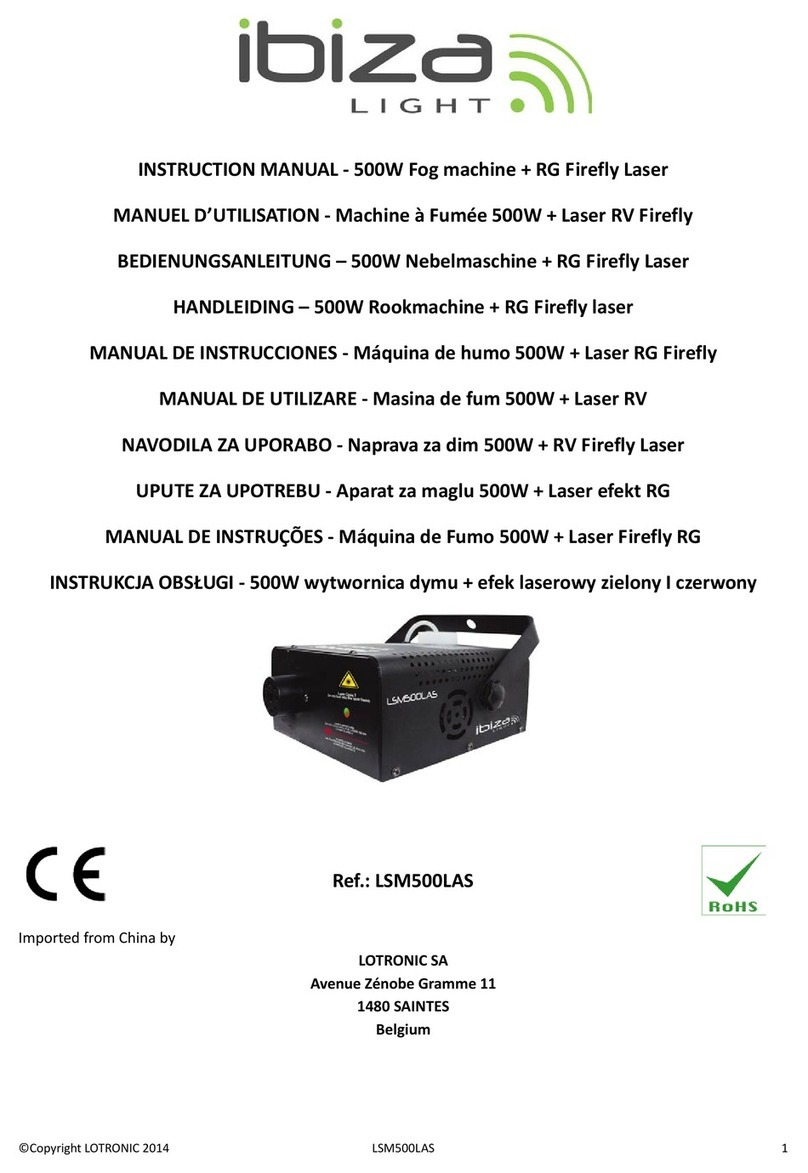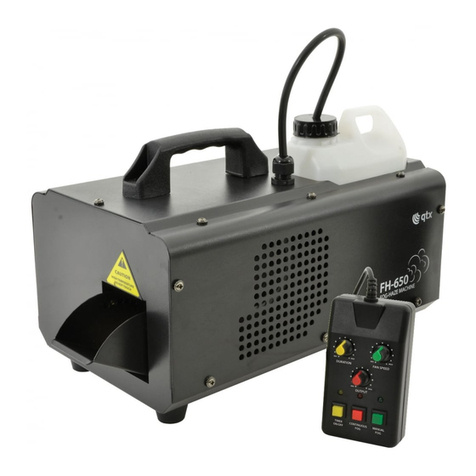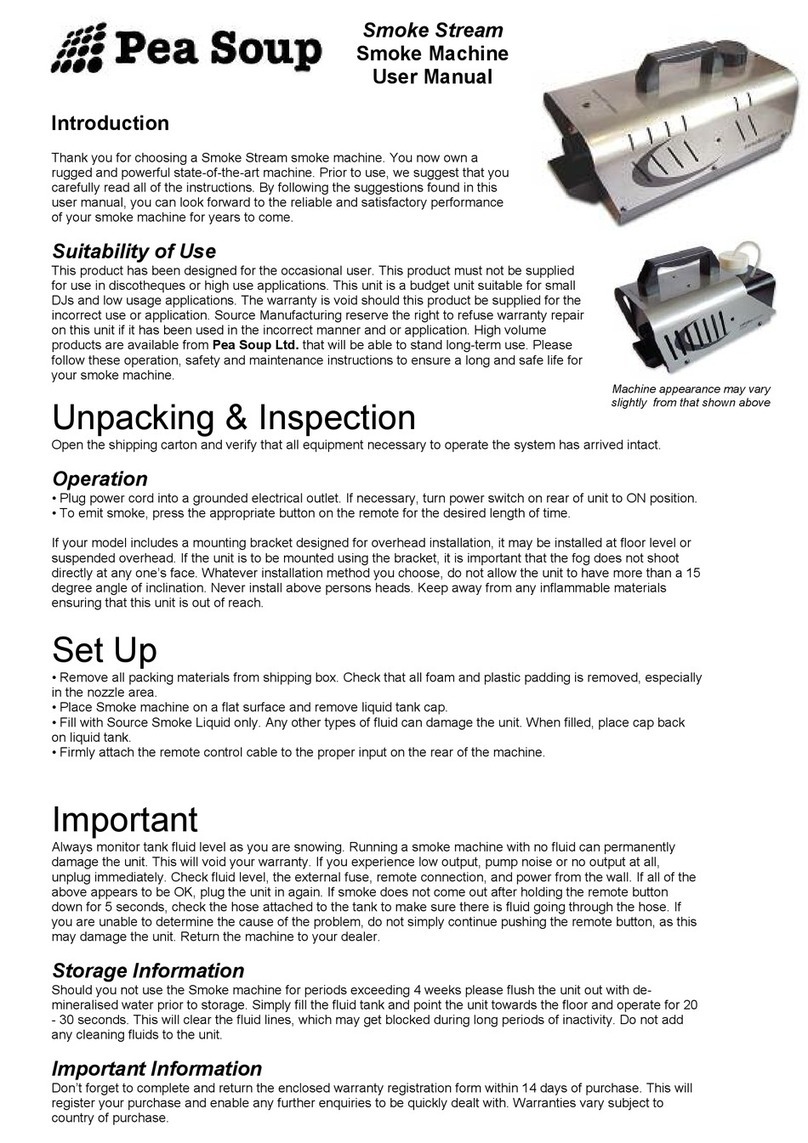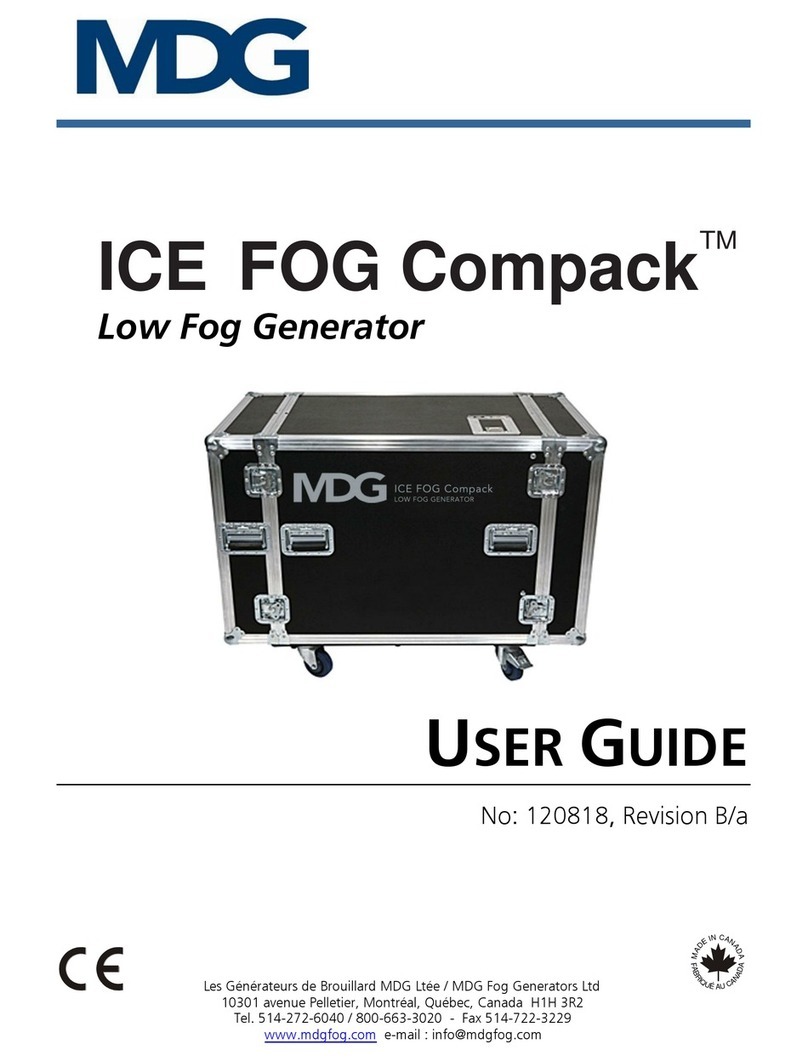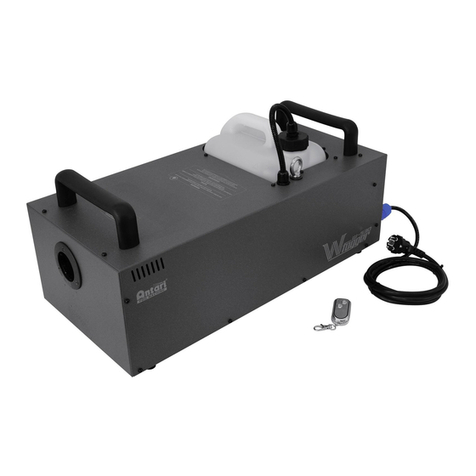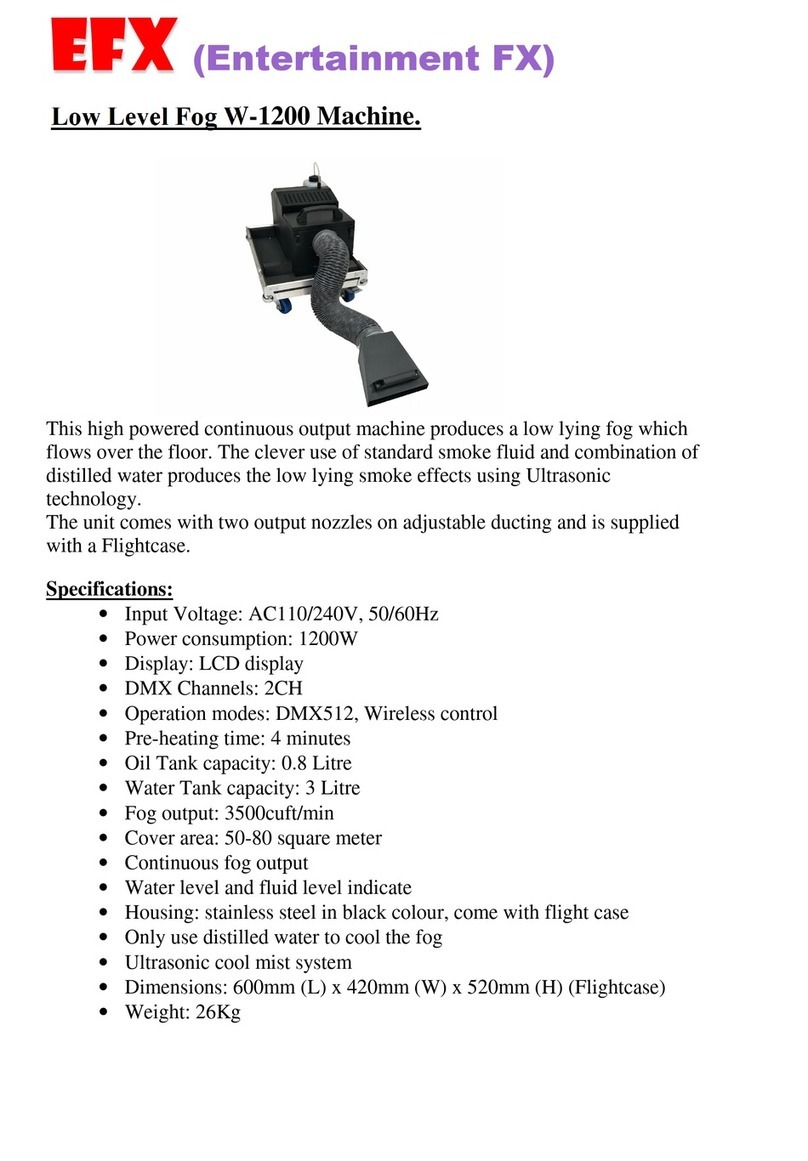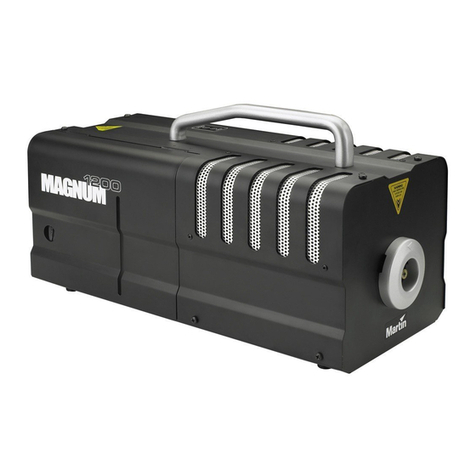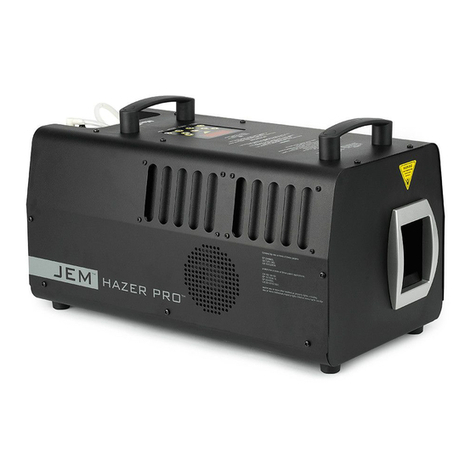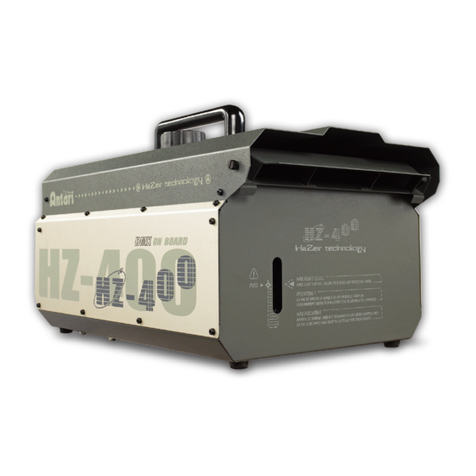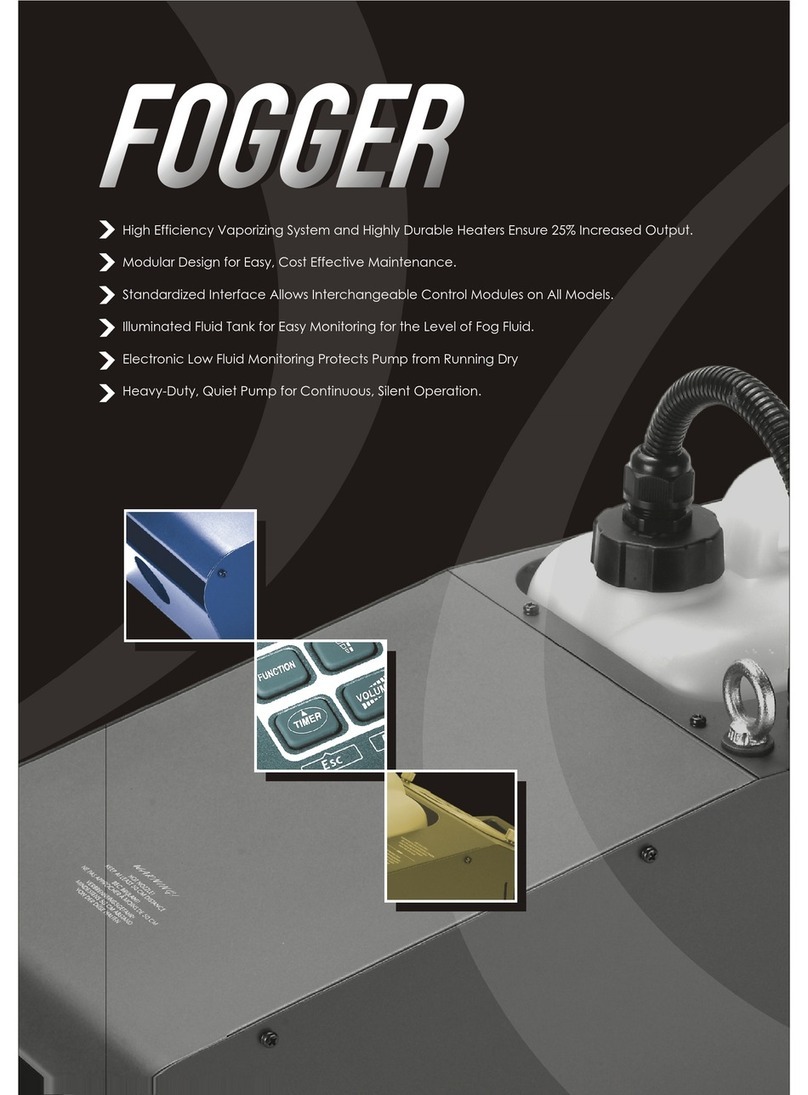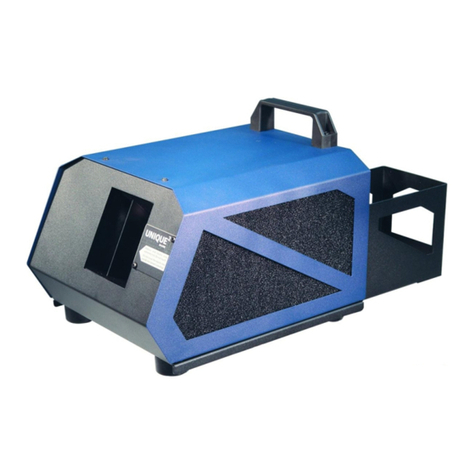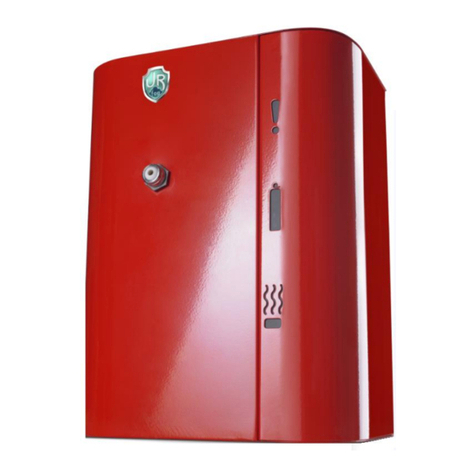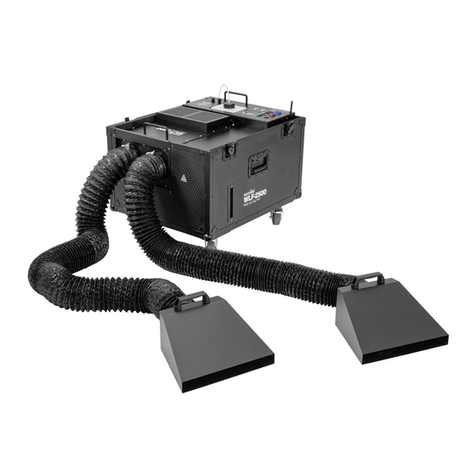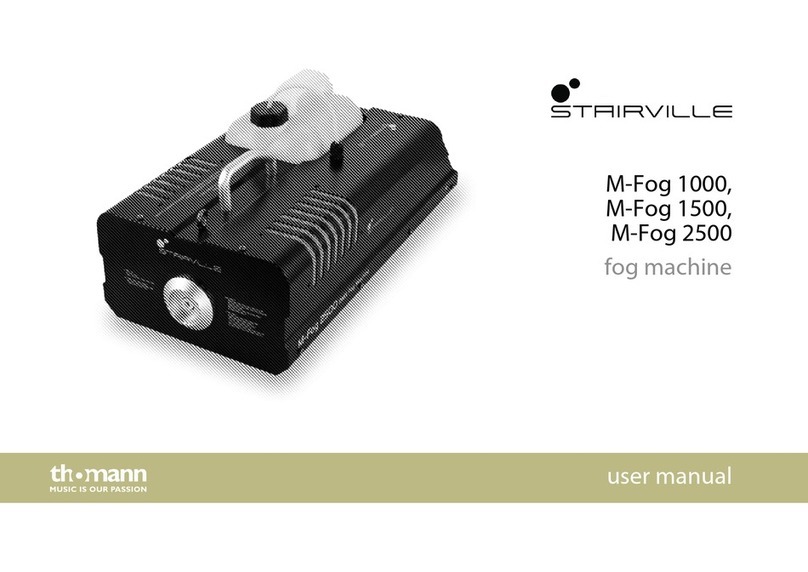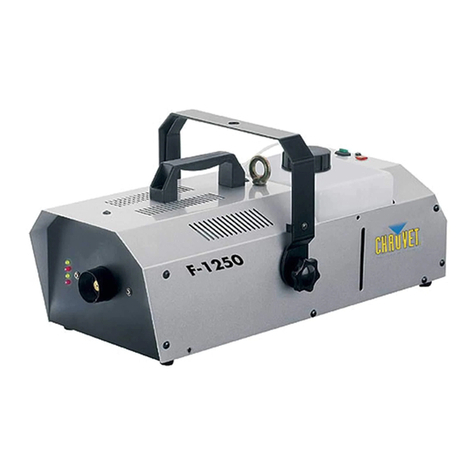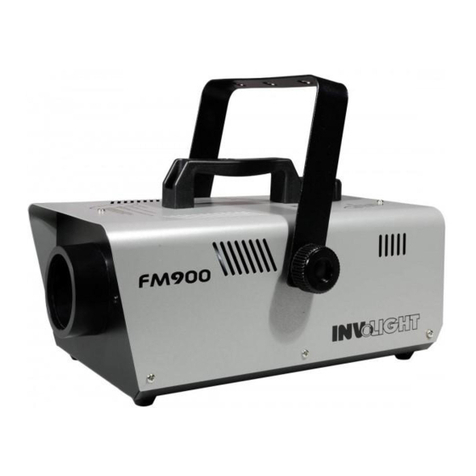MicroCool BIGHORN Series Instruction Manual

BIGHORN_March 2020.docx March 26, 2020 Page 1 of 36
Fog System
2020 Installation & Maintenance Manual Version 3 26
BIGHORN Series
MicroCool
Web site: www.microcool.com
Email: [email protected]
72216 Northshore St. #103-104
Thousand Palms, CA 92276, USA
Phone: +1-760-322-1111
Fax: +1-760-343-1820

BIGHORN_March 2020.docx March 26, 2020 Page 2 of 36
Table of Contents
1. BEFORE STARTING .................................................................................................................... 5
1.1 CRANKCASE OIL PLUG ......................................................................................................................................................... 5
1.2 OIL LEVEL ............................................................................................................................................................................. 5
1.3 INLET WATER SUPPLY PRESSURE. ....................................................................................................................................... 5
1.4 OIL CHANGE INTERVAL........................................................................................................................................................ 5
1.5 HIGH PRESSURE FITTINGS ................................................................................................................................................... 5
1.6INLET WATER SUPPLY PLUMBING MATERIAL..................................................................................................................... 5
1.7 FLUSHING THE SYSTEM ....................................................................................................................................................... 5
1.8 TEFLON TAPE ....................................................................................................................................................................... 5
2. WATER QUALITY ....................................................................................................................... 6
2.1 TOTALLY DISSOLVED SOLIDS COUNT .................................................................................................................................. 6
2.2 WATER ANALYSIS ................................................................................................................................................................ 6
2.3 WATER TREATMENT............................................................................................................................................................ 6
2.4 ULTRAVIOLET WATER PURIFIERS (OPTIONAL).................................................................................................................... 6
2.5 REVERSE OSMOSIS WATER TREATMENT (OPTIONAL)........................................................................................................ 6
3. INSTALLATION OF THE PUMP MODULE ..................................................................................... 7
3.1 PRE-INSTALLATION PROCEDURE......................................................................................................................................... 7
3.2 POSITIONING THE PUMP MODULE..................................................................................................................................... 7
3.3 WATER SUPPLY AND CONNECTION .................................................................................................................................... 7
3.4 INLET WATER HOSE............................................................................................................................................................. 7
3.5 PUMP DRAINAGE ................................................................................................................................................................ 7
4. PUMP MODULE POWER SUPPLY ............................................................................................... 8
4.1 ELECTRICAL SPECIFICATION................................................................................................................................................. 8
4.2 ELECTRICAL CIRCUIT ............................................................................................................................................................ 8
4.3 ELECTRICAL POWER SUPPLY ............................................................................................................................................... 8
4.4 TERMINAL STRIP - POWER .................................................................................................................................................. 8
4.5 ELECTRICAL CONNECTIONS- LOW VOLTAGE ...................................................................................................................... 8
5. BIGHORN – VFD BASICS............................................................................................................. 9
6. MICROCOOL BIGHORN - STARTING THE SYSTEM ...................................................................... 9
6.1 SYSTEM FLUSH..................................................................................................................................................................... 9
6.2 WATER & DRAIN VALVES .................................................................................................................................................... 9
6.3 TURN ON POWER ................................................................................................................................................................ 9
6.4 PUMP IS RUNNING.............................................................................................................................................................. 9

BIGHORN_March 2020.docx March 26, 2020 Page 3 of 36
6.5 LOW WATER PRESSURE .................................................................................................................................................... 10
6.6 SYSTEM RUN...................................................................................................................................................................... 10
7. PRESSURIZING THE SYSTEM .................................................................................................... 10
7.1 INSTALL DRAIN VALVES ..................................................................................................................................................... 10
7.2 MAN/OFF/AUTO SWITCH.................................................................................................................................................. 10
7.3 PRESSURE REGULATOR ..................................................................................................................................................... 10
8. DRAIN VALVE SEQUENCE ........................................................................................................ 11
8.1 SYSTEM ON/OFF................................................................................................................................................................ 11
8.2 RAMP DOWN..................................................................................................................................................................... 11
8.3 LOW SYSTEM SHOCK ......................................................................................................................................................... 11
9. SYSTEM OPERATION ............................................................................................................... 11
9.1 EXTERNAL CONTROLS........................................................................................................................................................ 11
9.2 TROUBLE SHOOTING CHART............................................................................................................................................. 12
10.SYSTEM MAINTENANCE .......................................................................................................... 12
10.1 CRANKCASE OIL ................................................................................................................................................................. 12
10.2 TYPE OF CRANKCASE OIL................................................................................................................................................... 12
10.3 ELECTRICAL MOTOR MAINTENANCE ................................................................................................................................ 12
10.4 INLET WATER FILTER ......................................................................................................................................................... 12
10.5 ATOMIZATION HOSE AND MANIFOLD.............................................................................................................................. 13
10.6 SYSTEM FLUSH – SHUT DOWN - WINTERIZING ................................................................................................................ 13
11. GUIDELINES FOR LOCATION AND INSTALLATION OF ATOMIZATION LINE ................................ 13
11.1 AIRFLOW............................................................................................................................................................................ 13
11.2 SUPPORTS & ALIGNMENT................................................................................................................................................. 13
11.3 NOZZLE ANGLE .................................................................................................................................................................. 13
11.4 NOZZLE DIRECTION ........................................................................................................................................................... 13
11.5 CEILINGS & SHADE SCREENS ............................................................................................................................................. 13
11.6 HOT SURFACES .................................................................................................................................................................. 13
11.7 DRAINAGE.......................................................................................................................................................................... 13
11.8 VENTING............................................................................................................................................................................ 13
11.9 TWISTS & KINKS................................................................................................................................................................. 14
11.10 SUPPORT & ROUTING ................................................................................................................................................... 14
12. INSTALLATION OF FLEXIBLE ATOMIZATION & MANIFOLD LINE FITTINGS ................................. 14
12.1 USE OF REUSABLE HOSE FITTINGS.................................................................................................................................... 14

BIGHORN_March 2020.docx March 26, 2020 Page 4 of 36
13. INSTALLATION OF REUSABLE HOSE FITTINGS........................................................................... 15
13.1 WARNING:......................................................................................................................................................................... 16
14. INSTALLATION OF STAINLESS STEEL LINE FITTINGS .................................................................. 16
14.1 INSTALLATION INSTRUCTIONS—TUBE FITTINGS .............................................................................................................. 17
14.2 INSTALLATION INSTRUCTIONS-TUBE BENDING................................................................................................................ 17
15. INSTALLATION OF ATOMIZATION LINE .................................................................................... 18
15.1 METHODS OF SUSPENDING ATOMIZATION LINES ........................................................................................................... 18
15.2 USE OF AIRCRAFT CABLE ................................................................................................................................................... 18
15.3 AIRCRAFT CABLE INSTALLATION TECHNIQUE................................................................................................................... 18
15.4 SPECIAL CONSIDERATIONS:............................................................................................................................................... 20
16. HOSE CLAMP INSTALLATION TECHNIQUE ................................................................................ 21
16.1 SPECIAL CONSIDERATIONS:............................................................................................................................................... 21
16.2 FLEXIBLE MANIFOLD OR FLEXIBLE NOZZLE LINE RELIEF ROUTING................................................................................... 22
17. ORIENTATION OF ATOMIZATION NOZZLES.............................................................................. 22
17.1 NOZZLE ANGLE .................................................................................................................................................................. 23
18. ATOMIZATION LINE/MANIFOLD HOSE DRAINAGE................................................................... 23
19. ATOMIZATION NOZZLES.......................................................................................................... 24
20. UL CERTIFICATE....................................................................................................................... 26
21. WARRANTY............................................................................................................................. 27
22. BIGHORN ILLUSTRATIONS ....................................................................................................... 28
22.1 BIGHORN FRONT EXTERNAL VIEW.................................................................................................................................... 29
22.2 BIGHORN BACK EXTERNAL VIEW ...................................................................................................................................... 30
22.3 BIGHORN RIGHT EXTERNAL VIEW..................................................................................................................................... 31
22.4 BIGHORN LEFT EXTERNAL VIEW ....................................................................................................................................... 32
22.5 BIGHORN TOP EXTERNAL VIEW ........................................................................................................................................ 33
22.6 BIGHORN TOP INTERNAL VIEW......................................................................................................................................... 34
22.7 BIGHORN CONTROL PANEL VIEW ..................................................................................................................................... 35
22.8 NOTES................................................................................................................................................................................ 36

BIGHORN_March 2020.docx March 26, 2020 Page 5 of 36
1. BEFORE STARTING
PLEASE READ THIS GUIDE ENTIRELY BEFORE BEGINNING INSTALLATION
ALSO, READ SUPPLEMENTAL INFORMATION RELATING
TO OPTIONAL CONTROL EQUIPMENT
1.1 CRANKCASE OIL PLUG
The pump module crankcase vent has been plugged to prevent accidental oil leakage during shipment. Remove the
plug and replace with the supplied vent cap before operating pump unit. Failure to do so will cause oil leaks.
1.2 OIL LEVEL
Check that the oil level appears 1/2 way in the sight gauge or within range on the dipstick in the pump head.
1.3 INLET WATER SUPPLY PRESSURE.
When the pump module is running, it must be supplied with an inlet water supply of
NEVER LESS THAN 20 P.S.I. (1.40 BAR) and NEVER MORE THAN 90 P.S.I. (6.20 BAR)
•Inlet water supply pressure should be steady and should not be allowed to fluctuate outside of these ranges.
Failure to do so can result in damage to equipment and is not covered by warranty.
•IF WATER PRESSURE DROPS BELOW 20 PSI, THE PUMP WILL SHUT OFF AND THE FAULT LIGHT
WILL COME ON. SEE SECTION 9 SYSTEM OPERATION FOR FUTHER INFORMATION.
1.4 OIL CHANGE INTERVAL
The crankcase oil must be changed after the first 50 hours of operation and from then on, once every 500 hours or
every 6 months, whichever comes first.
•synthetic 75w-90 gear oil is recommended for all applications (mobile one or equal)
•Secondary choice synthetic 15w-50 motor oil may be used for all applications (mobile one or equal)
1.5 HIGH PRESSURE FITTINGS
The system operates at 1,000 P.S.I. (70 bar) and should always be shut down when working on fittings or manifold
line. When adjusting the orientation of the nozzles, follow the procedures. Extreme caution should always be
exercised when working with high pressure water. Always wear safety glasses when working around fog equipment.
1.6 INLET WATER SUPPLY PLUMBING MATERIAL
Only rated and approved brass fittings or stainless steel fittings should be used to make plumbing connections. The
use of galvanized or steel pipe fittings can cause system failure, nozzle blockage and pump damage.
1.7 FLUSHING THE SYSTEM
Before pressurizing the system, flush all plumbing and atomization lines thoroughly to purge any residual debris.
Please refer to the startup section 7 of this manual.
1.8 TEFLON TAPE
When using Teflon tape on NPT threads, leave 1 or 2 of the starting threads showing. This will prevent pieces of
Teflon tape from entering the system, which could cause blockage or damage.

BIGHORN_March 2020.docx March 26, 2020 Page 6 of 36
WATER QUALITY
2. WATER QUALITY
To obtain the best performance, special consideration should be given to the quality of water used in a MicroCool
fog system.
MicroCoolIS NOT RESPONSIBLE FOR NOZZLE BLOCKAGE DUE TO POOR WATER QUALITY.
2.1 TOTALLY DISSOLVED SOLIDS COUNT
Water with total dissolved solids (TDS) counts of greater than 500 parts per million (PPM); water with high calcium
and magnesium carbonate levels, or water with pH levels below 6.5 and above 7.5 may not be satisfactory and could
lead to excessive nozzle blockage and nozzle maintenance.
2.2 WATER ANALYSIS
If there is any doubt about water quality, a water analysis is recommended. Of major interest is the water’s Langelier
Saturation Index (LSI) together with other items such as hardness and TDS. A slightly negative, or neutral, Langelier
index is preferred, whereas a positive index may indicate a tendency to form calcium carbonate deposits in the lines
and nozzles.If using city water, an analysis should be available from the city/town water department. If in any doubt,
please contact your MicroCool representative for further information.
2.3 WATER TREATMENT
Generally speaking most municipal water is suitable for atomization. Well water, river water and the like should be
tested before atomizing. If an analysis indicates any unusually high levels of undesirable elements proper treatments
are available. MicroCoolcan supply a variety of water treatment systems. Please contact MicroCoolfor further
details.
2.4 ULTRAVIOLET WATER PURIFIERS (OPTIONAL)
Optional ULTRAVIOLET high intensity light purifiers can also be installed on the inlet water supply to sterilize the
system water. By bombarding the water with UV light, dangerous pathogens, spores and germs are destroyed. UV
systems must be regularly serviced to maintain the correct high intensity output.
2.5 REVERSE OSMOSIS WATER TREATMENT (OPTIONAL)
MicroCool offers optional comprehensive reverse osmosis packages for all applications. Units are available for large
scale industrial as well as domestic installations.
Reverse Osmosis units incorporate a semi-permeable membrane that micro filters the water to 0.0001 microns
removing bacteria, viruses, aqueous salts and metal ions. By eliminating these from the supply water, MicroCool
ensures that clean, hygienic water is used in each system. Clean water will also reduce nozzle blockage, foul
smelling water and white “chalky” deposits on material close to the fog spray.
MicroCool reverse osmosis systems are designed specifically for each application – please consult with MicroCool
specialists for more details.

BIGHORN_March 2020.docx March 26, 2020 Page 7 of 36
3. INSTALLATION OF THE PUMP MODULE
3.1 PRE-INSTALLATION PROCEDURE
•Determine pump module location
•Identify water supply/connection for the system
•Determine routing of the high pressure manifold from the pump.
•Establish drainage location from the pump.
•Verify correct electrical power supply to the pump.
•Determine all of the above for optional Equipment - Sectioning Controllers, Temperature/Humidity
Controllers, Reverse Osmosis, UV sterilizers, etc...
3.2 POSITIONING THE PUMP MODULE
The pump module requires a flat, level surface. Position selection will largely depend on the availability of power and
water, but remember the points outlined on the previous pages as the terms of the pump warranty depend on it.
A concrete floor or a concrete slab is ideal. Using a level, ensure that the BIGHORN unit sits as level and plumb as
possible.
3.3 WATER SUPPLY AND CONNECTION
The water supply should be capable of 1.5 times the maximum flow of the pump as shown in the table below.
Pump Model & Flow
Minimum Flow Rate
USGPM
MIN Flow Rate
(LPM)
MIN Pressure psi /
bars
BIGHORN 1000
1.50
6.00
20 / 1.40
BIGHORN 2000
3.00
12.00
20 / 1.40
Correct water pressure and supply rate are essential to pump operation. All pump modules require a minimum of 20
P.S.I. (1.40 BAR) and a maximum of 90 P.S.I. (6.20 BAR) while in operation. The pressure should always be constant
and not fluctuate outside these ranges, especially on system start up. All pump modules are equipped with an inlet
water fault delay timer that tolerates small drops in pressure, but will ultimately “fault off” if low pressure is present
for more than a few seconds.
Ensure that either rubber hose, copper or PVC pipe is used
to provide the correct water supply to the BIGHORN unit.
Never use steel or galvanized steel fittings. Always use the
largest diameter pipe possible.
The inlet hose connection is 3/8” Female NPT Thread
The outlet hose connection is ¼” Male thread NPT
Use care and do not over tighten.
3.4 INLET WATER HOSE
MicroCool can supply an inlet hose connection kit for your
BIGHORN pump – call your MicroCool specialist and ask for
item number IHK0001.
3.5 PUMP DRAINAGE
After the pump module shuts down, the water remaining in the manifold lines will drain out through the pump module
and the end of the atomization lines. Ensure that the drain outlet is routed to a suitable drainage point to avoid
flooding.A 6 foot (1.8 M) low pressure drain hose is provided from the drain solenoid. This hose can be extended
as necessary.

BIGHORN_March 2020.docx March 26, 2020 Page 8 of 36
4. PUMP MODULE POWER SUPPLY
After all water and plumbing connections have been completed, a licensed, qualified electrician should connect the
power supply to the pump. It is important to follow the National Electrical Code (NEC), as well as any local codes to
ensure a safe installation.
4.1 ELECTRICAL SPECIFICATION
Establish that the circuit to be used to power the pump module is of the same electrical specification as the pump
module. The BIGHORN electrical specification can be found on the serial number data plate on the pump module
(inside the pump control box).
4.2 ELECTRICAL CIRCUIT
The circuit to the pump module must be dedicated and properly sized to carry the electrical load placed upon it by
the pump motor. Please refer to the serial number data plate on the pump module for more details.
4.3 ELECTRICAL POWER SUPPLY
The power supply to the pump module must be hard wired to a correctly rated fuse protected circuit complying with
NEC guidelines. NOTE: This pump unit has a frequency inverter. If local electrical code requires a GFCI (Ground
Fault Circuit Interrupted), this pump will require a special GFCI unit. Please contact MicroCool for details.
4.4 TERMINAL STRIP - POWER
After verifying all of the above, power should be on to the terminal strip located inside the NEMA 3R electrical
enclosure mounted on the pump module. We recommended that the correct sized wiring be in conduit (preferably
liquid tight); make the final connection to the high voltage terminal strip.
4.5 ELECTRICAL CONNECTIONS- LOW VOLTAGE
NOTE:All control wiring such as remote start must be SHIELDED cable of suitable size, for this application.
a. Resets VFD Drive
b. Open to Disable Manual ON/OFF
Enclosure
a.
b.

BIGHORN_March 2020.docx March 26, 2020 Page 9 of 36
5. BIGHORN – VFD BASICS
•The VFD (Variable Frequency Drive) controls the speed of the electrical motor (and subsequently the pump
head) by changing the Frequency (Hertz).
•The VFD is shipped with a minimum factory setting of 30 Hz. This will produce the minimum speed at which
the pump is still capable of adequate oil distribution within the crankcase.This minimum setting will ensure
reduced motor and pump wear.
•The VFD is factory set at a maximum of 60 Hz. This will produce the maximum designed water flow of the
pump at 1000 psi / 70 Bar.
•For more details on the VFD drive, the readings and fault status refer to the WEG Drive supplement which
is enclosed.
6. MICROCOOL BIGHORN - STARTING THE SYSTEM
6.1 SYSTEM FLUSH
The system must be flushed before pressurization. This removes any contaminants such as dirt, brass filings or
Teflon tape that have found their way into the system. At the end of each atomization line, there is a plug or an
automatic drain valve. Do not install plugs or automatic drain valves until the system has been completely flushed.
6.2 WATER & DRAIN VALVES
Turn on the water supply to the pump module. Ensure that the drain valves or plugs at the end of lines are not
installed.
6.3 TURN ON POWER
1. Turn on the power supply to the BIGHORN module, and then
turn the circuit breaker switch mounted inside the electrical
enclosure to the on position. Ensure the VFD reads “RDY”.
2. To start the pump, switch the “MAN/OFF/AUTO” switch to the
MAN position.
6.4 PUMP IS RUNNING
The pump system is now in operation. The VFD will increase the
speed of the motor / pump to maximum speed (60 Hz) to fill the
manifold and nozzle lines.
Switch to Manual ‘MAN’ Position

BIGHORN_March 2020.docx March 26, 2020 Page 10 of 36
6.5 LOW WATER PRESSURE
If the inlet water pressure gauge drops below 20 P.S.I. (1.4 BAR) (or out of the green zone) when the pump starts,
the pump will go into fault mode and will not start.
There must be between 20 PSI (1.4 BAR) and 90 PSI (6.2 BAR) of pressure available to the pump at all times
NOTE: should the water pressure drop below the factory preset of 20 psi, the system goes to E06 “FAULT”. The
system will automatically try to restart after a 30 second delay. If the water pressure has been restored, the
system will continue running normally.
The BIGHORN pump incorporates a delay timer on the water pressure switch that allows the system to run for a
few seconds before going to alarm.
If the water pressure has not been restored, the system will attempt to start a further two times at 30 second
intervals. If the water pressure has still not been restored, the system will remain in fault and will need to be
manually reset.
To reset the unit; turn the MAN/OFF/AUTO switch to the “OFF” position and press the “Red/Green Button” on the
VFD panel one time and release. The system is now reset.
The setting on the water pressure-sensing switch is factory preset at 20 PSI / 1.4 Bar and does not require any
further adjustment.
6.6 SYSTEM RUN
Let the module run for five minutes making sure that there is a good flow of water running out the end of each
atomization line. Lines may have to be flushed in groups with a large system. The system is now ready for
pressurization.
7. PRESSURIZING THE SYSTEM
Safety glasses must be worn when adjusting pressure. Always keep guards and covers in place.
7.1 INSTALL DRAIN VALVES
Install the automatic drain valves, or plugs, into the open ends of the atomization lines. Use Teflon tape on NPT
threads and tighten each fitting firmly. Do not apply tape to compression fittings.
7.2 MAN/OFF/AUTO SWITCH
Select the MAN (ON) position on the main switch. Select AUTO if using external controllers or switches. The VFD
will now adjust the speed of the motor / pump so that the system pressure is steady at 1,000 psi / 70 bar. Depending
on the number of nozzles running in the system at any particular time,
7.3 PRESSURE REGULATOR
DO NOT ADJUST THE PRESSURE REGULATOR.The regulator is installed as a safety valve only
and is factory set at 1200 psi / 84 Bar. Should the regulator be taken apart for any reason, the correct reassembly
sequence is shown below.
NEVER DISSASSEMBLE THE REGULATOR UNDER PRESSURE!
JAM NUT
ADJUSTABLE KNOB
SPRING
BRASS THRUST PLATE
STAINLESS BALL
PRESSURE RELIEF
POPPET
WASHER
O-RING
INLET PORT
SEAT
O-RING O-RING
BYPASS OUTLET

BIGHORN_March 2020.docx March 26, 2020 Page 11 of 36
If for any reason the regulator is adjusted, or changed, follow this procedure to reset the correct adjustment.
7.3.1 Turn off the electrical supply at the disconnect switch to electrically isolate the pump.
7.3.2 Locate the pressure transducer and unplug the electrical lead.
7.3.3 Restore the power and start the unit by selecting MAN (ON) position on the main switch.
7.3.4 Adjust the regulator by turning clockwise or counter-clockwise until the pressure gauge indicates 1,100
psi (75.8 Bar). When the pressure is steady at 1,100 make sure that the “Jam Nut” is tightened to lock
the adjustment in position.
7.3.5 Select OFF on the main switch to turn the pump off, disconnect the electrical supply.
7.3.6 Plug electrical lead back into transducer, restore electrical power.
8. DRAIN VALVE SEQUENCE
8.1 SYSTEM ON/OFF
TURN THE MAN/OFF/AUTO switch to the OFF position. The BIGHORN pump now enters its preprogrammed drain
sequence.
8.2 RAMP DOWN
The pump will electronically ramp down (slow to a stop) to avoid any water hammer. After a 3 second delay, the inlet
solenoid valve will close and the drain solenoid will open. The system pressure is relieved. Excess water will drain
out of the BIGHORN pump and the MicroCool nozzle system.
8.3 LOW SYSTEM SHOCK
This BIGHORN system, unique to the MicroCool pump range, is electronically activated to reduce system “shock”
and alleviates potential water hammer in the system that can damage the pump and the nozzle system. This
procedure is preprogrammed into the Variable Frequency Drive.
9. SYSTEM OPERATION
9.1 EXTERNAL CONTROLS
With external thermostats, humidity controllers or master control units correctly connected to the remote start
terminals in the Electrical Enclosure (see diagram above), MAN/OFF/AUTO switch must be set in the AUTO* position
and the MicroCool BIGHORN pump will operate in full automatic mode.
*If operating the BIGHORN pump in AUTO, the terminal/block switch inside the Electrical Enclosure should be
opened, disabling the MANUAL switch.
External Controls: Disable Manual Switch

BIGHORN_March 2020.docx March 26, 2020 Page 12 of 36
9.2 TROUBLE SHOOTING CHART
QUICK DIAGNOSTICS & TROUBLESHOOTING
PROBLEM
POINTS TO
CHECK
CORRECTIVE
ACTION
Pump runs but
does not build
pressure
•leaks in lines
•pump speed
•ensure drain
valve is closing
•repair leaks
•repair or replace
drain
Pump switch is on
but does not run,
no error on VFD
•power on
•remote switch in
on position
•switch on power
•ensure remote
switch & pump
switch are on
Pump switch is on
but does not run,
error E06 on VFD
•water pressure
•thermal switch
•filter cartridge
•restore water
pressure to
pump
•re-set thermal
switch
•change filter
cartridge
If the pump still does not run, contact MicroCoolfor further troubleshooting.
10. SYSTEM MAINTENANCE
10.1 CRANKCASE OIL
Initially the Crankcase Oil must be changed after the first 50 hours
operation.
After that it should be changed after every 500 hours of operation.
Examples of 500 hours operation:
•15 weeks of 5 hour operation per day
•9 weeks of 8 hour operation per day
•6 weeks of 12 hour operation per day
•3 weeks of 24 hour operation per day
10.2 TYPE OF CRANKCASE OIL
SYNTHETIC 75w-90 GEAR OIL IS RECCOMENDED FOR ALL APPLICATIONS (Mobil One or Equal)
In the event that 75w-90 is not available, synthetic 15w-50 Motor oil may be substituted (Mobil One or Equal)
10.3 ELECTRICAL MOTOR MAINTENANCE
All motors have sealed rotor bearings and do not require lubrication.
10.4 INLET WATER FILTER
The inlet water filter, 5-micron cartridge, must be regularly inspected. The durability of the
filter cartridge depends entirely upon the cleanliness of the inlet water. When the “outlet
gauge” shows a significant drop in pressure during operation or in particular if the needle
is in the red zone, it is time to change the filters. The filter cartridges should be changed
at least once every year.
Crankcase Oil Capacity
AR range
11 fl oz.
GIANT
11 fl oz.

BIGHORN_March 2020.docx March 26, 2020 Page 13 of 36
10.5 ATOMIZATION HOSE AND MANIFOLD
The hoses and lines should be periodically inspected for damage such as cuts and abrasions. Also check that the
hoses have not come into contact with sharp edges or are vibrating against an abrasive surface.
10.6 SYSTEM FLUSH – SHUT DOWN - WINTERIZING
If the system is to be SHUT DOWN for a period of time, all automatic drain valves or end plugs should be removed
and the complete system flushed. Then all water remaining in the lines should be air purged. The supply water to
the pump module should be turned off. Empty filter housings of any remaining water and replace filter cartridges
with new dry cartridges. Turn off electrical power to pump module. This will help to prevent water freezing and
damaging the pump or its components.
11. GUIDELINES FOR LOCATION AND INSTALLATION OF ATOMIZATION LINE
11.1 AIRFLOW
Fog evaporation and subsequent humidification or cooling is enhanced by air movement and flow. Continuous
cooling requires continuous ventilation (a fresh supply of warm or hot dry air). The proper installation and positioning
of the atomization lines across any prevailing airflow can seriously affect performance. Contact a MicroCool
Specialist for design recommendations.
11.2 SUPPORTS & ALIGNMENT
Align atomization lines with any existing rigid supports such as trusses, rafters, gutters, support poles or walls. If
such supports are not available or are not convenient, then suitable support structures should be designed and
fabricated to create maximum fog effectiveness.
11.3 NOZZLE ANGLE
The best nozzle angle may vary with application. Consult a MicroCool specialist for best advice.
11.4 NOZZLE DIRECTION
Avoid pointing atomization nozzles directly at or towards any close object or surface where the fog can collide before
evaporation. Adjust ROC nozzles or Flex line nozzles to avoid this situation. For welded stainless lines use of a
nozzle extender to change the spray direction or use a nozzle plug to block off the fog.
11.5 CEILINGS & SHADE SCREENS
If the atomization lines are to be installed below a ceiling or a shading structure, a distance of 18" to 24" (450mm to
600mm) should be preserved. This allows the nozzles to be orientated at the correct angle without directly spraying
on any surface.
11.6 HOT SURFACES
Flexible atomization lines or manifold hoses should never be allowed to come in direct contact with any hot surface.
They should be kept back a minimum distance of 39" (1mt) from steam pipes, heaters, hot surfaces, etc. If flexible
manifold lines must be routed across roof structures, it is recommended that they be protected and insulated from
both the hot roof surface and intense direct sunlight. Mounting flexible lines in PVC chase tubing is recommended.
Flexible lines/manifolds will shrink in normal applications. Allow at least 1” (2.5 cm) slack for every 10ft (3mt) lengths
during installation.
11.7 DRAINAGE
When using a municipal water supply, atomization lines and manifold hoses should be installed so they will drain. It
is important that all lines be installed with a gradient of at least 1:100. Pitch all lines back to the pump and use auto
drain vales at the end of each line.
11.8 VENTING
In some instances, it is advisable to install an automatic drain valve pointed straight up, if there is a high point in the
system that cannot otherwise drain. This allows air to enter the system when draining, speeding up the drainage
time. Conversely, this will allow air to leave the system when filling/pressurizing and eliminates trapped air pockets.

BIGHORN_March 2020.docx March 26, 2020 Page 14 of 36
11.9 TWISTS & KINKS
Avoid twisting and kinking the flexible lines/manifolds while un-spooling and installing. Thermoplastic hose has a
"memory" and after a period of time will tend to twist back into the original position. When installing flexible nozzle
lines, use of the special tool to re-align nozzles is recommended. Failure to do so may result in twisted lines that
may initially look fine but under pressure will move considerably.
11.10 SUPPORT & ROUTING
Whatever support method is used, both atomization and manifold hoses must be routed carefully and held securely.
It is important they are not allowed to excessively vibrate, sag unduly, bend around a radius of less than 6" (15cm)
or be permitted to come into contact with sharp edges. Always leave extra line when bending around corners and
making bends to compensate for shrinkage.
12. INSTALLATION OF FLEXIBLE ATOMIZATION & MANIFOLD LINE FITTINGS
12.1 USE OF REUSABLE HOSE FITTINGS
Reusable hose fittings have standard 1/4", 3/8" and 1/2" National Pipe Thread (NPT) for connection to each other or
to other standard brass fittings. Teflon tape must always be used on the male threads of any fitting to create a liquid
tight seal. However, the stem component of a reusable hose fitting, i.e. that bit that screws down inside the hose,
should never be wrapped with Teflon tape. The following diagrams illustrate typical uses for reusable hose fittings:
HI GH PRE SSURE
HOSE
RE USABL E HOSE
FI T T I NG BARRE L
RE USABL E HOSE
FITTING STEM
No tape here
12.1.1 Female swivel fittings have a rotating head that allows connections to
be made without having to rotate the hose as the fitting is screwed into
position. Reusable hose fittings can be used in conjunction with any standard
brass fitting to permit connection with the pump modules or solenoid valves.
No Teflon tape is required with this fitting.
12.1.2 Male fittings have a rigid NPT thread that can be fixed to a female
NPT fitting. This allows manifold hoses or atomization lines to be connected
or branched. Teflon tape must be wrapped around the male threads of any
fitting to create a liquid tight seal, except when a female swivel reusable hose
fitting is connected to the male fitting.
12.1.3 Female ¼” Rigid fittings are always used at the end of flexible
atomization lines to hold an automatic drain valve or a plug.
12.1.4 Do not over-tighten fittings. Fittings may crack and leak.

BIGHORN_March 2020.docx March 26, 2020 Page 15 of 36
13. INSTALLATION OF REUSABLE HOSE FITTINGS
Reusable hose fittings are used to make high pressure hose connections. They are used to join manifold hoses to
high-pressure pump modules, atomization lines and for numerous other applications. There are various styles of
reusable hose fittings, but the method used to fit them to hose is the same.
Figure 1: Tools Required
Figure 2: Screw Ferrule onto
Hose Counter/Anti Clockwise
Figure 3: Tighten Ferrule on
Hose
Figure 4: Stop Tightening when
the Line is within 1/16”-1.6 mm
of Thread
Figure 5: Dip Applicator in
Silicone
Figure 6: Apply Silicone to
Stem
Figure 7: Apply Silicone to
Inside of Ferrule
Figure 8: Screw Stem into
Ferrule
Figure 9: Using a Wrench,
Screw in the Ferrule
Figure 10: Stop with 1/8” - 3mm
Gap
Figure 11: Fitting Installed
Figure 12: Female Swivel
Fittings Do NOT Require Tape
on the Male Fitting

BIGHORN_March 2020.docx March 26, 2020 Page 16 of 36
13.1 WARNING:
Improper end fitting installation or lack of lubrication during end fitting installation will cause the inner lining of the
hose to be torn, leading to leakage, hose swelling or a blockage. Line shrinkage will also cause leakage. The hose
will swell and/or leak water within 6” of the fitting if installed incorrectly.
Always keep the hose straight and make sure the hose, barrel and stem are lubricated and in alignment during the
assembly process. See figure 3 below showing described problems. These conditions are not warrantable.
Figure 3. – Examples: Improper Installation of Re-usable Hose Fitting
Swollen & Leaking Hose
Blocked Collapsed Hose
14. INSTALLATION OF STAINLESS STEEL LINE FITTINGS
Stainless steel compression fittings are used to make high-pressure line connections. They are used to join manifold
lines to high-pressure pump modules, atomization lines and for numerous other applications. Although there are
various styles of compression tube fittings, the method used to install them is the same.
UNION MALE CONNECTOR FEMALE CONNECTOR 90° ELBOW
TEE CONNECTION
Union- ...........................Fitting used to connect two pieces of stainless steel tubing.
Male Connector- ...........Fitting used to connect stainless steel tubing to female reusable hose fittings.
Female Connector- ......Fitting used to connect stainless steel tubing to auto drain valves.
90 Elbow-.......................Fitting used to connect stainless steel tubing around 900corners.
Tee Connection- ...........Fitting used to connect stainless steel tubing at an intersection.
Figure 13: National Pipe Thread
Male (NPTM) Requires PTFE
Tape on the Thread
Figure 14: National Pipe Thread
Female (NPTF) Requires PTFE
Tape on the Male Thread
Example1: Swollen & Leaking Hose
Example 2: Blocked & Collapsed Hose

BIGHORN_March 2020.docx March 26, 2020 Page 17 of 36
14.1 INSTALLATION INSTRUCTIONS—TUBE FITTINGS
For proper fitting performance, the tubing surface finish should be clean, free from nicks or scratches. Do not use
out-of-round tubing, which does not easily go through fitting components.
NOTE:These instructions apply to traditional fittings and fittings with the
advanced back ferrule geometry.
Insert tubing into the compression tube fitting (Fig. 1).
Make sure that the tubing rests firmly on the shoulder of the tube fitting body
and that the nut is finger-tight.
Scribe the nut at the 6 o’clock position (Fig. 2).
While holding fitting body steady, tighten the nut 1 1/4 turns to the 9 o’clock
position. (Fig. 3)
14.2 INSTALLATION INSTRUCTIONS-TUBE BENDING
The stainless steel tubing may be bent to fit around objects with a tubing
bender. MicroCool tool part# TKT0012 may be used or you may obtain one
locally.
Figures 1-3.

BIGHORN_March 2020.docx March 26, 2020 Page 18 of 36
15. INSTALLATION OF ATOMIZATION LINE
15.1 METHODS OF SUSPENDING ATOMIZATION LINES
The two basic methods used to mount and suspend atomization lines are
1. Stainless Steel Aircraft Cable.
2. Hose Mounting Clamps.
The type of structure and the location where the atomization lines will be installed determines the appropriate
method. Often a combination of methods is used.
15.2 USE OF AIRCRAFT CABLE
Aircraft Cable is 7 x 7 stranded 1/16” (0.31mm) stainless steel cable, rated at about 500 lbs. tensile strength. With
this method, the atomization line is attached using cable ties at approximately 12"(304mm) on-center. It is extremely
important that the cable be installed along the top of the atomization line with the cable tie snaps being placed on
the hose, not the cable. See figure 6.
The Aircraft Cable is strung between posts, columns or a fabricated structure that locates the atomization line in the
desired position. The cable is then drawn tight by a ratchet mechanism. This method allows atomization line to span
distances of up to 10 to 15 feet (3 to 5 MT) where there is lack of continuous support.
Typical situations where this method would be useful are fixing atomization line to structures of greenhouses, storage
houses, waste load-out facilities, perimeter fencing around sludge ponds or strung between poles to span across
sewage lagoons. The possibilities are numerous.
15.3 AIRCRAFT CABLE INSTALLATION TECHNIQUE
Special tools required: Aircraft Cable cutter & 1/16" Sleeve crimping tool.
(Aircraft cable tool kit MicroCool PART# TKT0003)
1. Select the two points from which you require your manifold line or atomization line to span. Points may be
existing structures such as roof beams, columns, etc. or fabricated poles that will allow cable to be wrapped
around.
2. If the points are on a wall or any other flat surface, eyelets will have to be fabricated to fix the ends of the cable.
Remember, to create a drainage gradient for the atomization lines, the points must not be level.
3. Pull one length of Aircraft Cable between the two points. Pull an extra 2 feet (0.61 M) and cut using the cable
cutter.
4. The Aircraft Cable ends are generally fixed by forming a loop and this is held using crimp sleeves. Please refer
to the following drawing.
Figure 4. – Fixing First End of Aircraft Cable
1. CRIMP SLEEVES SLIDE ONTO
& DOWN THE AIRCRAFT CABLE
3. END OF CABLE FED THROUGH
CRIMP SLEEVES
2. AIRCRAFT CABLE LOOPED AROUND POST
STRAINING POST
5. Take one end of the Aircraft Cable and pull it around the point in the above fashion. Use the crimping tool and
firmly crimp each sleeve three times along its length.

BIGHORN_March 2020.docx March 26, 2020 Page 19 of 36
Figure 5. – Fixing Ratchet Strainer to Aircraft Cable
6. The other end of the Aircraft Cable is now
ready to be fixed, however, the cable will have
to be tightened or tensioned to prevent the
atomization line from sagging and to create
the necessary drainage gradient. To do this a
ratchet tightener must be installed in the line.
7. To install the ratchet tightener, use the short
length of Aircraft Cable supplied with the
ratchet and form a loop by running the short
length of cable through the eyelet, around the
post and secure with two crimp sleeves. Next,
run the end of the support Aircraft Cable
through the revolving pin taking up as much
slack as possible. Then, secure using one
crimp sleeve.
8. Using a wrench, twist the revolving pin to take
up the remaining slack in the support Aircraft
Cable. Keep twisting until the Aircraft Cable is tight and does not sag. Make sure that the Aircraft Cable is
straight and is not being deflected by other object.
9. Unroll the atomization line on the ground below the Aircraft Cable. Do not allow the atomization line to become
excessively dirty and make sure the protective caps on the end of the nozzles and lines remain in place. While
on the ground, it may be convenient to align the nozzles into the desired position; however, this is reasonably
straightforward to do when the line is suspended.
10. Take one end of the atomization line and using zip ties (part# ACT0009); attach the complete line to the cable
loosely. Connect atomization line to manifold line. Proceed from this point working your way to the end of the
atomization line tightening the zip ties and orientating the nozzles to your preferred spray direction. Attach zip
ties to atomization line at a distance of no more than 12” (300mm). Please refer to figure 7 on page 12. Zip tie
lock clip should be mounted away from Aircraft Cable. This will attach atomization line to cable securely.
11. When finished the atomization line should be suspended as illustrated in figure 8.
Figure 6 – Fixing Atomization Line to Aircraft Cable
ATOMIZATION NOZZLE
CABLE TIES AIRCRAFT CABLE
SIDE VIEW
RATCHET STRAINER
FIXING POST
SUPPORT AIRCRAFT CABLE
SIDE VIEW
FIXING POST SUPPORT AIRCRAFT CABLE
RATCHET STRAINER
TOP VIEW
WIRE LOOP
WIRE LOOP
CRIMP SLEEVE
CRIMP SLEEVE

BIGHORN_March 2020.docx March 26, 2020 Page 20 of 36
Figure 7 – Suspended Aircraft Cable and Atomization Line
RATCHET STRAINER/ AIRCRAFT CABLE
POLE/ COLUMN POLE/ COLUMN
AIRCRAFT CABLE
ATOMIZATION LINE
AUTOMATIC DRAIN VALVE
Figure 8 – Supporting Atomization Line at Mid-Span
ROOF STRUCTURE
VERTICAL SUPPORTS
ATOMIZATION LINE
12. The weight of the atomization lines may cause the Aircraft Cable to sag. To overcome sagging it is necessary
to support the atomization line along its length. In the diagram below, short lengths of Aircraft Cable have been
attached to a roof structure and then dropped and fixed to the Aircraft Cable supporting the atomization line at
an interval of 10 to 15 feet. (3 to 4.5 MT). Please refer to figure 6. Always consider line drainage when
suspending overhead atomization lines.
15.4 SPECIAL CONSIDERATIONS:
Do not attempt to install lines without intermediate support.
***NOTE: When wrapping flexible atomization line or manifold around a corner or coming to the end of a
long run, leave approx. 4” to 6” extra per 10 foot of manifold line to account for possible line shrinkage.
Failure to do so will result in line or fitting leakage or damage. See page 13, figure 9a for more
information.
This manual suits for next models
2
Table of contents
Other MicroCool Fog Machine manuals
